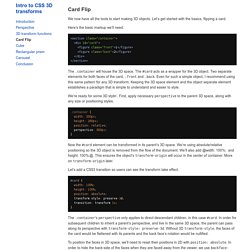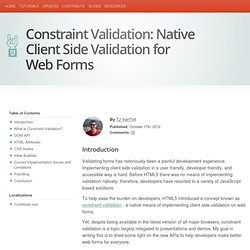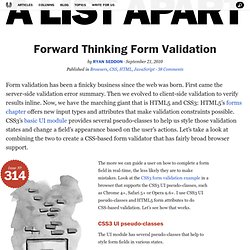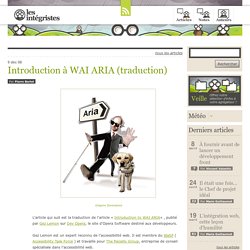

HTML5 Video. Miro Video Converter FREE - Convert any video to MP4, WebM (vp8), iPhone, Android, iPod, iPad, and more. Card Flip · Intro to CSS 3D transforms › Docs. We now have all the tools to start making 3D objects.

Let’s get started with the basics, flipping a card. Here’s the basic markup we’ll need: <section class="container"><div id="card"><figure class="front">1</figure><figure class="back">2</figure></div></section> The .container will house the 3D space. The #card acts as a wrapper for the 3D object. We’re ready for some 3D stylin’. Now the #card element can be transformed in its parent’s 3D space. Let’s add a CSS3 transition so users can see the transform take effect. The .container’s perspective only applies to direct descendant children, in this case #card. To position the faces in 3D space, we’ll need to reset their positions in 2D with position: absolute. To flip the .back face, we add a basic 3D transform of rotateY( 180deg ). With the faces in place, the #card requires a corresponding style for when it is flipped.
Animez vos pages HTML5 avec CSS3. Constraint Validation: Native Client Side Validation for Web Forms. Introduction Validating forms has notoriously been a painful development experience.

Implementing client side validation in a user friendly, developer friendly, and accessible way is hard. Before HTML5 there was no means of implementing validation natively; therefore, developers have resorted to a variety of JavaScript based solutions. To help ease the burden on developers, HTML5 introduced a concept known as constraint validation - a native means of implementing client side validation on web forms. Yet, despite being available in the latest version of all major browsers, constraint validation is a topic largely relegated to presentations and demos. In this tutorial I will: Present a comprehensive overview of what constraint validation is. What is Constraint Validation? The core of constraint validation is an algorithm browsers run when a form is submitted to determine its validity.
As an example take this form with an empty required text input: Try It. Www.paris-web.fr/2012/HTML5-stockage-local-et-synchronisation.pdf. Forward Thinking Form Validation. Form validation has been a finicky business since the web was born.

First came the server-side validation error summary. Then we evolved to client-side validation to verify results inline. Now, we have the marching giant that is HTML5 and CSS3: HTML5’s forms chapter offers new input types and attributes that make validation constraints possible. CSS3’s basic UI module provides several pseudo-classes to help us style those validation states and change a field’s appearance based on the user’s actions. Let’s take a look at combining the two to create a CSS-based form validator that has fairly broad browser support. Issue № 314 The more we can guide a user on how to complete a form field in real-time, the less likely they are to make mistakes.
CSS3 UI pseudo-classes#section1 The UI module has several pseudo-classes that help to style form fields in various states. valid invalid required optional in-range out-of-range read-only read-write Additional types and attributes to help us#section2. Cross Browser Testing Tool - BrowserStack. Typekit. Modernizr: the feature detection library for HTML5/CSS3. HTML5 Rocks - A resource for open web HTML5 developers.
S. Introduction à WAI ARIA (traduction) Grégoire Dierendonck Cet article est destiné à des personnes ne connaissant pas ARIA.

Vous devriez avoir une bonne connaissance du langage HTML et des problèmes que peuvent rencontrer les personnes handicapées sur le web. Connaître quelques application web « riches » (RIA) d’un point de vue utilisateur serait un plus. Après avoir lu cet article, vous comprendrez à quoi sert ARIA, comment l’intégrer à vos sites, et comment l’utiliser dès immédiatement et même sur le plus simple des sites pour le rendre plus accessible. Introduction Le langage HTML (HyperText Markup Language) n’a pas été conçu pour créer des applications web. Malheureusement, les techniques utilisées pour outrepasser ces limitations ne sont absolument pas accessibles.
Les mises à jour sont souvent mal perçues par les personnes utilisant une technologie d’assistance. Petit historique du langage HTML Applications web Reproduction d’applications bureau Requêtes serveur en arrière plan Reproduire des composants riches (widgets) main. Les intégristes. Apprendre le HTML5 – Tutoriel Complet.
Tutoriel complet pour apprendre le HTML5 – Quelque soit votre niveau, ce cours est fait pour vous.

Que vous débutiez dans la création de site internet ou que vous maitrisez déjà le xHTML et / ou le HTML 4.01, découvrez toute la puissance du HTML5. Chaque chapitre est rédigé de façon concise et compréhensible par tous. Ils sont divisés en thèmes consultables indépendamment suivant votre niveau et vos connaissances. Chaque point détaillé est inclus dans un exemple concret et certains sont accompagné de démo consultable en ligne. L’ensemble du cours – en constante évolution - est accessibles à tous quelque soit votre niveau : Un problème, une suggestion ou une remarque : Poser votre question ou venez en discuter sur notre forum.